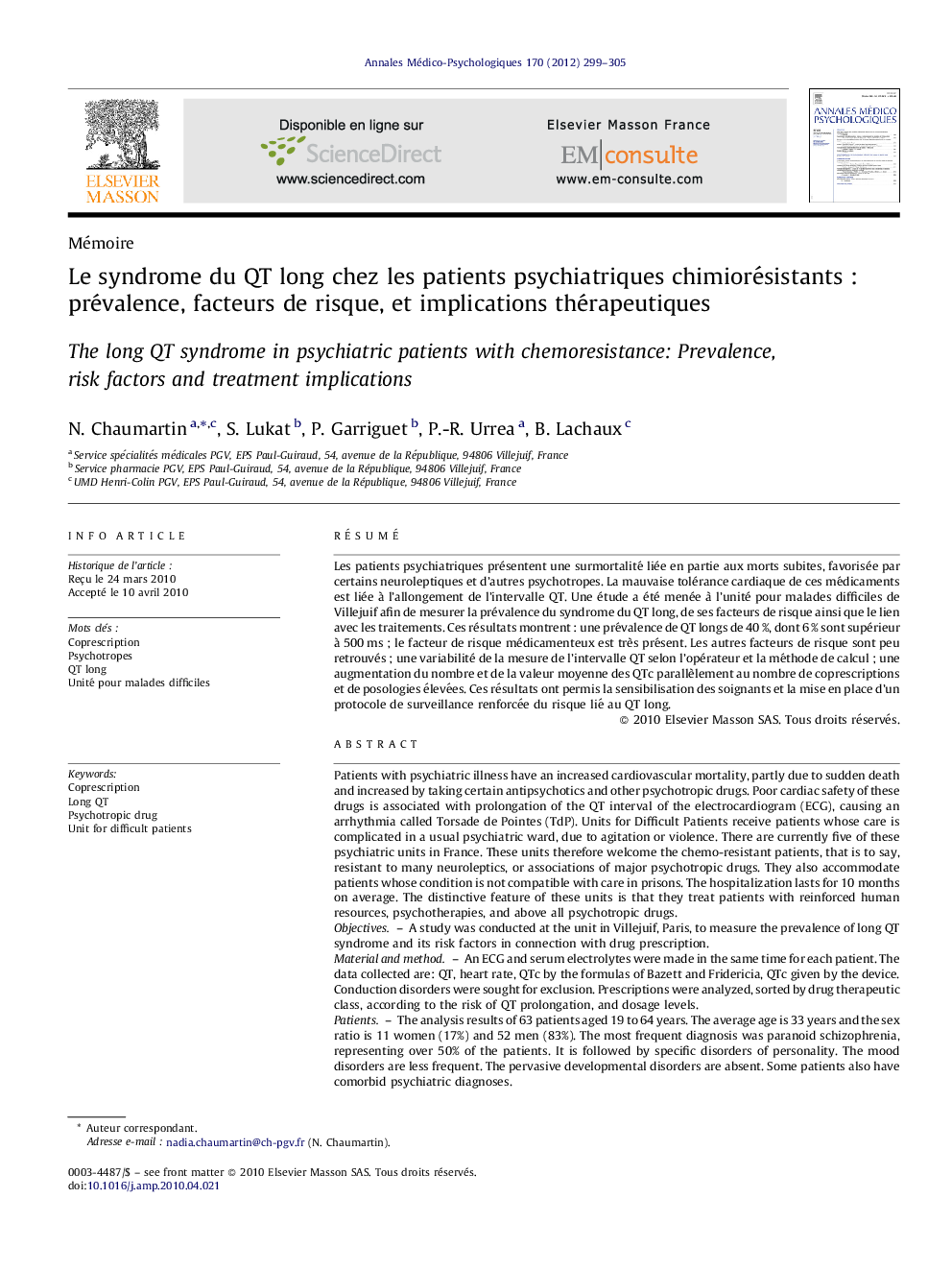| کد مقاله | کد نشریه | سال انتشار | مقاله انگلیسی | نسخه تمام متن |
|---|---|---|---|---|
| 312606 | 534233 | 2012 | 7 صفحه PDF | دانلود رایگان |

RésuméLes patients psychiatriques présentent une surmortalité liée en partie aux morts subites, favorisée par certains neuroleptiques et d’autres psychotropes. La mauvaise tolérance cardiaque de ces médicaments est liée à l’allongement de l’intervalle QT. Une étude a été menée à l’unité pour malades difficiles de Villejuif afin de mesurer la prévalence du syndrome du QT long, de ses facteurs de risque ainsi que le lien avec les traitements. Ces résultats montrent : une prévalence de QT longs de 40 %, dont 6 % sont supérieur à 500 ms ; le facteur de risque médicamenteux est très présent. Les autres facteurs de risque sont peu retrouvés ; une variabilité de la mesure de l’intervalle QT selon l’opérateur et la méthode de calcul ; une augmentation du nombre et de la valeur moyenne des QTc parallèlement au nombre de coprescriptions et de posologies élevées. Ces résultats ont permis la sensibilisation des soignants et la mise en place d’un protocole de surveillance renforcée du risque lié au QT long.
Patients with psychiatric illness have an increased cardiovascular mortality, partly due to sudden death and increased by taking certain antipsychotics and other psychotropic drugs. Poor cardiac safety of these drugs is associated with prolongation of the QT interval of the electrocardiogram (ECG), causing an arrhythmia called Torsade de Pointes (TdP). Units for Difficult Patients receive patients whose care is complicated in a usual psychiatric ward, due to agitation or violence. There are currently five of these psychiatric units in France. These units therefore welcome the chemo-resistant patients, that is to say, resistant to many neuroleptics, or associations of major psychotropic drugs. They also accommodate patients whose condition is not compatible with care in prisons. The hospitalization lasts for 10 months on average. The distinctive feature of these units is that they treat patients with reinforced human resources, psychotherapies, and above all psychotropic drugs.ObjectivesA study was conducted at the unit in Villejuif, Paris, to measure the prevalence of long QT syndrome and its risk factors in connection with drug prescription.Material and methodAn ECG and serum electrolytes were made in the same time for each patient. The data collected are: QT, heart rate, QTc by the formulas of Bazett and Fridericia, QTc given by the device. Conduction disorders were sought for exclusion. Prescriptions were analyzed, sorted by drug therapeutic class, according to the risk of QT prolongation, and dosage levels.PatientsThe analysis results of 63 patients aged 19 to 64 years. The average age is 33 years and the sex ratio is 11 women (17%) and 52 men (83%). The most frequent diagnosis was paranoid schizophrenia, representing over 50% of the patients. It is followed by specific disorders of personality. The mood disorders are less frequent. The pervasive developmental disorders are absent. Some patients also have comorbid psychiatric diagnoses.ResultsThese results show: prevalence of long QT syndrome by 40% according to the formula of Bazett (including 6 % > 500 ms, major risk of TdP); the preponderance of medicinal risk factor, present in all patients. Other risk factors for QT prolongation are rare (hypokalaemia and bradycardia: 1.6%, female: 17%). The risk factors for TdP are frequent (hypomagnesemia: 8%, hypocalcemia: 46%, renal dysfonction 11%), some of which can be corrected; a measurement variability of the QT interval with significant differences (p < 0.001) by the operator and the method of calculation used (Bazett, Fridericia…); increase in the number and average values of long QTc with the number of drugs associated with QT lengthening; lastly, an increase of number and average values of long QTc with high doses.ConclusionsThe prevalence of long QT syndrome in our study is higher than that usually found in the literature. The associations of psychotropic drugs are many, evidence that drug resistance is present. These treatments involve many molecules presented as lengthening the QT. Patients with the longest QT, are those having most associated drugs and higher doses. However, despite the proven toxicity of these treatments, it must be remembered that the QT prolongation does not necessarily a negative risk-benefit balance. This is assessed on a case-by-case basis to determine the right practice. These results emphasize the need for increased surveillance of risk associated with long QT patients on psychotropic associations. They now have awareness of carers and the establishment of a protocol for enhanced surveillance in the service.
Journal: Annales Médico-psychologiques, revue psychiatrique - Volume 170, Issue 5, June 2012, Pages 299–305